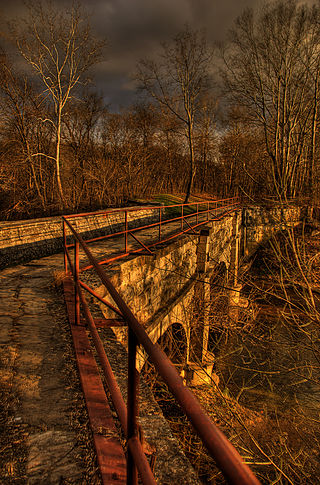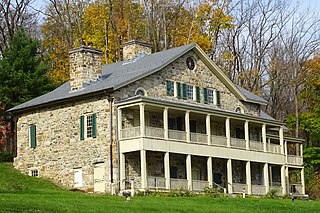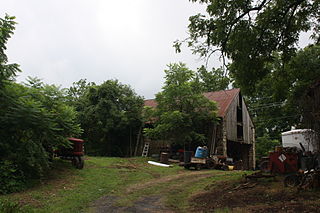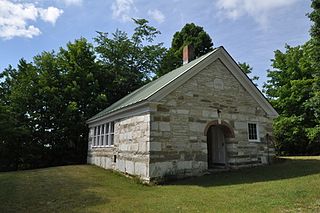
The Anaconda Smelter Stack is the tallest surviving masonry structure in the world, with an overall height of about 585 feet (178.3 m), including a brick chimney 555 feet (169.2 m) tall and the downhill side of a concrete foundation 30 feet (9.1 m) tall. It is a brick smoke stack or chimney, built in 1918 as part of the Washoe Smelter of the Anaconda Copper Mining Company (ACM) at Anaconda, Montana, in the United States. A terra cotta coating covered the entire brick chimney when new, but by the time the smelter closed in 1981, most had eroded away except for the upper 40%, exposing most of its bricks and reinforcing rods. The inside diameter at the bottom of the brick chimney is 76 feet (23.2 m) while that at the top is about 60 feet (18.3 m). The stack and its viewing area are now the two-part Anaconda Smoke Stack State Park.

Onota was a village in the Upper Peninsula of the U.S. state of Michigan. It was located on the Grand Island Bay of Lake Superior near the present-day community of Christmas about five miles (8 km) west of Munising in Alger County. The site of Onota is within the Bay Furnace Campground and Picnic Area of the Hiawatha National Forest. The remains of Bay Furnace, a blast furnace used for smelting iron, is the only extant remnant of the town. Bay Furnace was listed on the National Register of Historic Places and designated a Michigan State Historic Site in 1971.

St. Clair Flats Front and Rear Range Light are two lighthouse structures situated off the southeastern tip of Harsens Island at Lake St. Clair.

Cornwall Furnace is located near Cedar Bluff, Alabama, United States, in Cherokee County. It was built by the Noble Brothers to supply iron products to the Confederate States of America during the American Civil War.

Longdale Furnace is an unincorporated community located east of Clifton Forge in Alleghany County, Virginia, United States.

Antietam Iron Furnace Site and Antietam Village is a national historic district at Antietam, Washington County, Maryland, United States. It consists of the remains of a mid-18th to late-19th century iron furnace site, and the nearby related village. Remnants of the ironworks include a dam and race, a possible wheel pit or building foundation, the possible location of a furnace stack, and a four-arch stone bridge built by John Weaver in 1832. Also at the site are the dozen or so brick, stone, and wood houses comprising Antietam Village. Typical of the houses is the Mentzer house, a four-bay, two-storey stone structure of roughly coursed fieldstone, painted white.
This is a list of the National Register of Historic Places listings in Stewart County, Tennessee.

The Brierfield Furnace, also known as the Bibb Naval Furnace and Brierfield Ironworks, is a 486-acre (197 ha) historic district in Brierfield, Alabama, United States, that includes one building and nine sites. It was listed on the National Register of Historic Places on November 20, 1974. The Alabama Historic Ironworks Commission maintains 45 acres (18 ha) as Brierfield Ironworks Historical State Park.

Shippen Manor is located in Oxford Township, Warren County, New Jersey, United States. The manor was built in 1755 and was added to the National Register of Historic Places on December 20, 1984, for its significance in architecture and industry. It was later added as a contributing property to the Oxford Industrial Historic District on August 27, 1992.

The Monroe Furnace is a national historic district and historic iron furnace that are located in Barree Township in Huntingdon County, Pennsylvania.

Barree Forge and Furnace, now known as Greene Hills Methodist Camp, is a national historic district located at Porter Township in Huntingdon County, Pennsylvania. It consists of two contributing buildings, one contributing site, and one contributing structure associated with a former ironworks. They are the ironmaster's mansion, furnace stack, a barn, and the site of the Barree iron forge built about 1797. The ironmaster's mansion was built in the 1830s, and is a 2 1/2-story brick house painted white. The furnace stack dates to 1864, and is a 30-foot square, coursed limestone structure. It measures between 6 and 15 feet tall. The ironworks closed in the 1880s. The property was acquired in 1963, by the United Methodist Church for use as a church camp.

Dale Furnace and Forge Historic District, also known as Dale Iron Works and Mt. Chalfont Furnace, is a historic "iron plantation" and national historic district located in Washington Township, Berks County, Pennsylvania. The district encompasses six contributing buildings and one contributing site. They are a stone horse barn, stone and frame bank barn, ironmaster's mansion, smokehouse and wash house (1827), stone worker's house (1830), and counting house. The archaeological site includes the ruins of a worker's house, the stone furnace stack, bank iron furnace, forge foundations and race, and remnants of dam breast. The furnace remained in blast until about 1822, and the Dale Forge was in operation until 1868.

The Beckley Furnace Industrial Monument is a state-owned historic site preserving a 19th-century iron-making blast furnace on the north bank of the Blackberry River in the town of North Canaan, Connecticut. The site became a 12-acre (4.9 ha) state park in 1946; it was added to the National Register of Historic Places in 1978.

Mt. Torry Furnace, also known as Virginia Furnace, is a historic iron furnace located at Sherando, Augusta County, Virginia. It was built in 1804, and is a stone square trapezoid measuring 30 feet at the base and 40 feet tall. The original cold-blast charcoal stack was converted for hot blast in 1853. It shut down in 1855, then was reactivated in 1863 to support the Confederate States Army. The furnace was destroyed in June 1864 during the American Civil War by Brigadier General Alfred N. Duffié, then rebuilt in January 1865. It operated until 1884.

The Furnace Grove Historic District encompasses the remains of a historic 19th-century iron processing facility near Bennington, Vermont. Located on the north side of Vermont Route 9 east of the town center, its production peaked in the 1830s, and was afterward converted into a gentleman's farm. Surviving elements of its past include the remains of iron smelting furnaces, housing, and agricultural outbuildings. The district was listed on the National Register of Historic Places in 1997.

The Cooley Covered Bridge is a covered bridge that carries Elm Street across Furnace Brook in Pittsford, Vermont. Built in 1849, it is one of a small number of bridges in the state that has a well-documented association with the 19th-century master bridgewright Nicholas M. Powers, who grew up nearby. It is one of four surviving 19th-century covered bridges in the town, and was listed on the National Register of Historic Places in 1974.

The Sudbury School No. 3, also known as the Hill School, is a historic district school building at the junction of Vermont Routes 30 and 73 in Sudbury, Vermont. Built in the 1820s, it is a well-preserved example of the period, executed in stone. It was listed on the National Register of Historic Places in 1978.
Moselle Iron Furnace Stack is a historic iron furnace stack located near Moselle, Franklin County, Missouri. It was built in 1848-1849 by the Moselle Iron Furnace (1850-1854), and later operated as the Furnace of the Franklin Iron Mining Co. (1855-1859), and Moselle Iron Company (1874-1875). It is 31 feet high and constructed of cut stone blocks. The furnace was closed in early June 1875.

The Fitchburg Furnace is a historic iron furnace located in the Daniel Boone National Forest in Estill County, KY.
Valley Furnace, also known as Fanny Furnace and Brushy Fork Furnace, is a historic blast furnace near Valley Furnace, West Virginia. The furnace operated from 1847 to about 1855, after which the site was abandoned. After 1965 the site became a roadside park operated by the West Virginia Division of Highways. In 2002 the property was transferred to the Barbour County Commission for use as a park. The site has not been developed for park use.




















